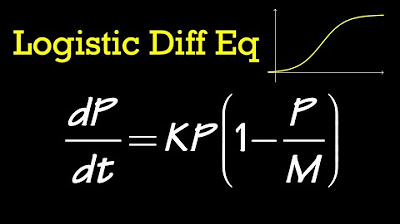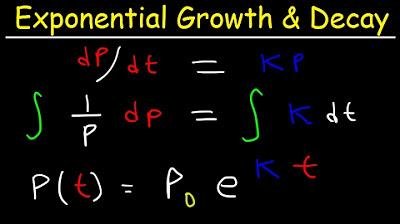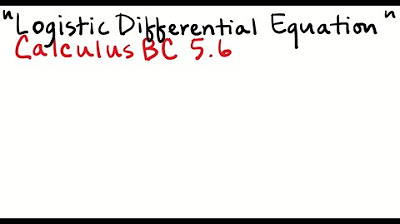AP Calc BC: How to Solve a Logistic Growth Application Problem
TLDRThe video script discusses a logistic growth model application problem involving a tank with a maximum capacity of 150 guppies. Initially, six guppies are introduced. The growth rate is given by the equation dp/dt = 0.0015 * P * (150 - P), where P is the population and t is time in weeks. The logistic formula is explained, identifying constants K (0.0015) and M (150), and finding the constant A (24) using initial conditions. The formula for the guppy population in terms of time T is derived as P = 150 / (1 + 24 * e^(-0.225T)). The video then calculates the time it takes for the guppy population to reach 100 and 125, using the derived formula and solving for T. The results indicate it takes approximately 17.21 weeks for a population of 100 and about 21.28 weeks for 125, demonstrating the application of the logistic growth model to predict population dynamics over time.
Takeaways
- 📈 The logistic growth model is used to describe the growth of a population that is limited by carrying capacity, in this case, a tank with a maximum of 150 Guppies.
- 🧮 The general logistic formula is dp/dt = k * P * (M - P), where k is the growth rate constant, P is the population size, and M is the carrying capacity.
- 🌱 The initial condition given is that there are six Guppies in a 2,000g tank, which can support up to 150 Guppies.
- 🔍 The rate of growth equation provided is dp/dt = 0.0015 * P * (150 - P), which includes the specific growth rate constant (0.0015) and carrying capacity (150).
- ⏱ Time is measured in weeks for this application problem.
- 🔑 Capital A is a constant that will be determined using the initial conditions of the problem.
- 🔧 By using the initial condition P(0) = 6, the value of A is calculated to be 24, which is a crucial step in finding the formula for the Guppy population in terms of time T.
- 📐 The formula for the Guppy population in terms of T is P = 150 / (1 + 24 * e^(-0.225T)), which is derived from the logistic growth model and the given initial conditions.
- ✅ Part B of the problem asks to find the time it takes for the Guppy population to reach 100 and 125, which is solved by setting P equal to these values in the derived formula and solving for T.
- 🕒 Using the formula, it is calculated that it will take approximately 17.21 weeks for the population to reach 100 Guppies and about 21.28 weeks to reach 125 Guppies.
- 📊 The natural log function is used to isolate the exponential term e^(0.225T) and solve for T in the logistic growth equation for specific population targets.
Q & A
What is the carrying capacity of the tank in terms of the number of Guppies it can support?
-The carrying capacity of the tank is 150 Guppies, which represents the maximum number of Guppies the tank can support without negative consequences.
How many Guppies are initially introduced into the tank?
-Initially, six Guppies are introduced into the tank.
What does the logistic growth model represent in this context?
-The logistic growth model represents the rate of growth of the Guppy population in the tank, taking into account the limited space and resources, and it is given by the equation dp/dt = 0.0015 * P * (150 - P).
What are the variables K and M in the logistic growth model?
-In the logistic growth model, K is the growth rate constant, which is 0.0015 in this case, and M is the carrying capacity, which is 150 for the Guppy population.
How is the constant A in the logistic growth formula determined?
-The constant A is determined using the initial conditions of the problem. In this case, it is found by setting the population P at time T=0 to 6, which gives A = 24 after solving the equation.
What is the formula for the Guppy population in terms of time T?
-The formula for the Guppy population in terms of time T is P = 150 / (1 + 24 * e^(-0.225 * T)), where T is measured in weeks.
What does the logistic growth model assume about the growth rate of a population?
-The logistic growth model assumes that the growth rate of a population is proportional to the population size and the amount of space available (carrying capacity), meaning that the growth rate decreases as the population approaches the carrying capacity.
How long does it take for the Guppy population to reach 100 Guppies according to the model?
-According to the model, it takes approximately 17.21 weeks for the Guppy population to reach 100 Guppies.
How long does it take for the Guppy population to reach 125 Guppies according to the model?
-According to the model, it takes approximately 21.28 weeks for the Guppy population to reach 125 Guppies.
What mathematical operation is used to solve for the time T when the population reaches certain levels?
-The mathematical operation used to solve for the time T is taking the natural logarithm (Ln) of both sides of the equation and then isolating T by dividing by the growth rate constant.
Why does the time to reach a higher population level (125 Guppies) take longer than a lower one (100 Guppies)?
-The time to reach a higher population level takes longer because as the population approaches the carrying capacity, the growth rate slows down due to limited resources and space, following the logistic growth curve.
What is the significance of the initial condition in determining the formula for the Guppy population?
-The initial condition is crucial as it provides the starting point for the population growth. It allows for the calculation of the constant A, which is then used in the logistic growth formula to model the population at any given time T.
Outlines
📚 Introduction to Logistic Growth Model
The video begins with an introduction to solving a logistic growth model application problem. It presents a scenario involving a 2,000g tank that can initially support 150 Guppies. The problem involves introducing six Guppies into the tank and using a given equation to represent the population growth rate. The logistic growth formula is explained, with the carrying capacity (M) set to 150 and the growth rate constant (K) as 0.0015. The initial condition is that at time T=0 (zero weeks), there are six Guppies. The video guides viewers through deriving the formula for the Guppy population in terms of time (T), which is measured in weeks.
🧮 Calculating the Guppy Population Formula
The video continues with a detailed explanation of how to calculate the formula for the Guppy population over time. It involves substituting the known values of M (150) and K (0.0015) into the logistic growth equation. Using the initial condition where the population (P) is six at T=0, the video demonstrates how to solve for the constant 'a', which turns out to be 24. With this value, the formula for the Guppy population in terms of T is established. The video then moves on to solving for the time it takes to reach specific population sizes, specifically when the population is 100 and 125 Guppies.
⏳ Time to Reach Specific Population Sizes
The final part of the video script addresses the question of how long it will take for the Guppy population to reach 100 and 125. The formula derived from the logistic growth model is used to calculate the time (T) for these two scenarios. By substituting P=100 and P=125 into the formula and solving for T, the video shows the steps to isolate the exponential term and then take the natural log of both sides. This process yields two different time values: approximately 17.21 weeks for the population to reach 100 Guppies and about 21.28 weeks for it to reach 125 Guppies. The video concludes by summarizing the process used to solve the problem and the results obtained.
Mindmap
Keywords
💡Logistic Growth Model
💡Carrying Capacity (M)
💡Initial Population (P)
💡Growth Rate (dp/dt)
💡Constant K
💡Initial Condition
💡Population at Time T (P of T)
💡Exponential Function (e^x)
💡Natural Logarithm (Ln)
💡Time to Reach Population Threshold
💡Solving for Time (T)
Highlights
The logistic growth model is used to solve a problem involving a 2,000g tank with an initial population of six Guppies.
The tank has a carrying capacity of 150 Guppies, which is the maximum number it can support.
The growth rate equation is dp/dt = 0.0015 * P * (150 - P), representing the rate of growth for the Guppy population.
The general logistic formula is introduced as dp/dt = K * P * (M - P), where M is the carrying capacity and K is a constant.
The constant K is determined to be 0.0015 based on the given growth rate equation.
The variable A is a constant to be found using the initial conditions of the problem.
The initial condition is that at time T=0 (zero weeks), there are six Guppies in the tank.
The formula for the Guppy population in terms of time T is derived using the logistic formula and initial conditions.
The value of A is calculated to be 24 using the initial condition of six Guppies at T=0.
The final logistic growth formula for the Guppy population is P = 150 / (1 + 24 * e^(-0.225T)).
The time required for the Guppy population to reach 100 is calculated to be approximately 17.21 weeks.
For a population of 125 Guppies, it is determined that it would take about 21.28 weeks.
The natural log function is used to solve for the time T in both scenarios of population growth.
The problem-solving approach involves substituting values into the derived formula and using cross-products to solve for T.
The logistic growth model is applied to predict population growth under specific conditions of time and carrying capacity.
The solution provides a practical application of the logistic model in predicting and managing fish tank populations.
The process demonstrates the use of mathematical modeling to solve real-world problems related to population dynamics.
Transcripts
Browse More Related Video

Logistic Differential Equation (general solution)

Logistic Growth (Separable Differential Equations)

Exponential Growth and Decay Calculus, Relative Growth Rate, Differential Equations, Word Problems

The Logistic Equation and the Analytic Solution

Logistic Differential Equation

The Logistic Equation and Models for Population - Example 1, part 1
5.0 / 5 (0 votes)
Thanks for rating: